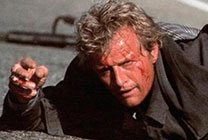|
|
|
|
The Hitcher
|
 |
|
There are movies in the action/thriller/horror matrix
where the symbolism attached to evil is crucial and often quite specific,
whether on literal or metaphoric levels; and movies where it is effectively
absent – a blank or neutral villainy that can be taken to mean many things, or
pretty much nothing, just a necessary, functional piece of a filmic story. The Hitcher, a powerhouse highpoint of
1980s genre cinema, is an example of the latter. I can think of few films that
boast less “content” or theme – but this is not a criticism!
The Hitcher aims purely and
simply to be a mechanism – a wonderfully inventive mechanism, reaching only for
showbiz effect. It comes on like a mixture of the Mad Max series and Steven Spielberg’s breakout telemovie Duel (1971) – the latter being the model
case of a film with a portentous premise (deadly truck with mysterious, unseen
driver) that could be suggestive of many things, but just does not wish to “go
there”; rather, it’s left up to spectators to whip up and project their own
interpretations, if they so please. The film itself provides neither answers
nor clues.
The premise of The
Hitcher is, as in Duel, slim (or,
as fans of tough-guy cinema prefer to say, “lean”): the perpetually renewed
battle, along the road, between an innocent young lad, Jim (C. Thomas Howell
from Soul Man), and a very evil man, Ryder
(Rutger Hauer at his peak), who appears to be both omnipresent and superhumanly
powerful. Ryder’s endgame philosophy becomes chillingly clear in the course of
the tale: he will keep killing until somebody works up the courage to kill him. And, even then, he may not be dead
– at which point, director Robert Harmon and fresh-out-of-film-school writer
Eric Red borrow and vary a few moves from contemporary horror movies such as
John Carpenter’s Halloween (1978) and
its accumulated offspring.
Like Blood
Simple (with its jolting revelation of the precocious talent of the Coen
brothers), The Hitcher is a dazzling
piece of filmmaking. Every tiny element of physical action is turned by Harmon
into an almost overwhelming sound-and-image event (especially when experienced
on a big, Panavision screen in a good theatre): a drop of water falling from
the villain’s nose, a match lit in the dark, a shadow passing in front of the
camera (the type of “jump scare” that is already prime cliché material), the
noise of a lone car on a distant highway. It’s comprised of heightened,
exaggerated textures – so thick as to be smothering, and thus intensifying the
ambience of perpetual unease.
The Hitcher also plays,
teasingly, with its own essential implausibility. This effect of
unbelievability extends to all levels: for example, the two main male figures
are so entirely different in their
acting styles and behavioural responses that, whenever both share the same
frame, you could almost swear you’re seeing two separate movies unfussily sewn
together at the middle of the screen.
My only reservation about The Hitcher concerns a stretch somewhere in roughly its final 20
minutes. Here, it does seem to want to claim for itself some piece of
seriousness – spiritual, metaphysical, supernatural, something of that order.
The tensions that have hitherto held it together go slack at this point. But
this is a minor, forgivable lapse in such a finely crafted, well-oiled machine.
Back on the plus side, The Hitcher is a film of gross angles, hard edges, and mad vectors.
If there ever can be such a thing as “pure form” or “pure cinema”, this is it. Enjoy
it on a big screen if you can; and then at a later moment you can break down
its many moves with your pause button at home.
Postscript 2019: Robert Harmon was a director on whom my ‘80s cinephile generation
pinned much hope; sadly, nothing in his subsequent film and TV output even
approximately scaled the heights of The Hitcher – which was itself
the subject of a poor sequel (The Hitcher II: I’ve Been Waiting) in 2003 and a pale remake (by Dave Meyers)
in 2007. Eric Red has also had an unusual and somewhat disappointing career arc:
after writing The Hitcher, and still
in his 20s, he partnered with Kathryn Bigelow on two other stone-cold ‘80s
classics, Near Dark (1987) and Blue Steel (1990). He began directing
features himself: Cohen and Tate (1989), Body Parts (1991) and the telemovie Undertow (1996, another script from the Bigelow collaboration) all have
interesting elements, but do not entirely fire. After a tragic road accident
and its legal aftermath derailed his career in the 2000s, he mainly turned to prolific
novel writing. C. Thomas Howell, too, became a director (of sorts) in-between
his many B to Z grade film roles: his Hourglass (1995) is among the very worst
movies I have ever endured.
MORE Harmon: Highwaymen © Adrian Martin December 1986 |
![]()